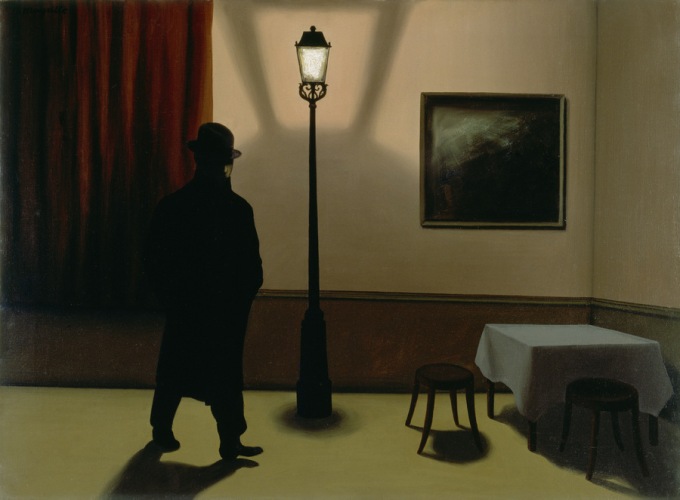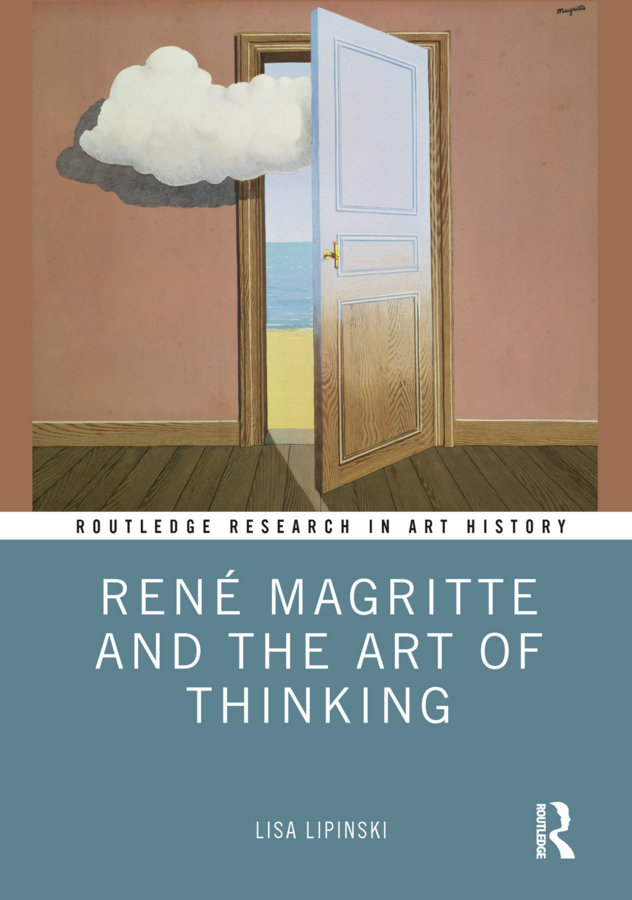
[Image: René Magritte, La mémoire (1948), oil on canvas, 60 x 50 cm. Collezione della Fédération Wallonie-Bruxelles (FWB) Ministère de la Communauté française, Bruxelles
© 2018 Prolitteris, Zurich]
Magritte: Life Line is catalogue is produced for the solo exhibition of René Magritte (1898-1967) at Amos Rex, Helsinki (8 February-19 May 2019) and Museo d’arte della Svizzera italiana, Lugano (16 September 2018-6 January 2019). The basis of this exhibition is a lecture given in 1938 by Magritte. The curator and writers have taken his biographical lecture as a starting point for the selection of art by Magritte, using it to illustrate the themes he identified as his most important ones.
The lecture “Life Line” was delivered on 20 November 1938 at Koninklijk Museum voor Schone Kunsten, Antwerp. The text is reprinted here in full. The artist greeted his audience with the words “Ladies, Gentlemen, Comrades” and included a swipe at Hitler. Magritte’s political commitment was never entirely full and it fluctuated. His support always seemed more an expression of anti-authoritarianism and opposition to Fascism rather than any desire to see a dictatorship of the proletariat. Surrealism implied members’ allegiance to Communism, as repeatedly stated in the movement’s manifestoes and statements. The speech was more about an undermining of our assumptions regarding reality and the natural laws than anything more polemical. He talks about the origins of his fascination with painting.
In my childhood, I used to enjoy playing with a little girl in the old disused cemetery in a small provincial town. We visited the underground vaults, whose heavy iron door we could lift up, and we would come up into the light, where a painter from the capital was painting in a very picturesque avenue in the cemetery with its broken stone pillars strewn over the dead leaves, the art of painting then seemed to me to be vaguely magical, and the painter gifted with superior powers.
For Magritte, art was bound up with magic and eroticism. His wish to make himself and others wonder in order to experience the world anew and the erotic impulse were twin motivations for Magritte as artist during his whole life.
Encounters with paintings by first the Futurists and then Giorgio de Chirico inspired Magritte to turn away from realism. When Magritte read the manifestoes and saw the art of Surrealism, he located a means of combining wonder and eroticism. In 1925 he began to explore the terrain which would come to be considered typically and uniquely Magrittean. Through inversion, metamorphosis, replacement of images by words and juxtaposition Magritte transformed aspects of the real world into something remarkable. In the early years unknown and impossible substances and painterly effects were part of his repertoire but in the years after 1930 this part diminished and Magritte dealt henceforth mainly with materials and objects that we recognise.
One night in 1936, I woke up in a room with a bird asleep in a cage. Due to a mahnificent delusion I saw not a bird but an egg inside a cage. Here was an amazing new poetic secret, for the shock I felt was caused precisely by an affinity between the two objects, cage and egg, whereas before, this shock had been caused by bringing together two unrelated objects.
Hereafter, Magritte treated his ideas as more consistent and less arbitrary. In Hegel’s Vacation a glass of water is balanced on an open umbrella. The conjunction is between an object which is used to contain water and one that is designed to repel water. This is typical of the newly refined process of image creation.
Magritte goes on to give some examples of his paintings as representative of his thought, rejecting the idea that painting was to give sensual pleasure. This was a position he temporarily reversed in the Second World War, creating paintings in the Impressionist style of Renoir to delight the senses in delicate brushwork and spectacular warm colour. The lecture text is accompanied by the original glass slides that the artist projected on the evening.
The catalogue includes an interview with Suzi Gablik. She stayed with the Magrittes in 1960 while preparing her landmark monograph on the artist. She discusses her memories of the Magrittes domestic life. Other texts analyse Magritte’s interest in Futurism, his relations with the Paris Surrealists and his partnership with his America-based dealer Alexandre Iolas. There is a bibliography and chronology.
There are versions of famous paintings included in the exhibition. Among these are The Red Model (with boots metamorphosing into feet), The Castle in the Pyrenees (a castle on a rock which floats over a sea), The Listening Room (a giant apple fills a room), Memory (a plaster cast of a woman’s head is splashed with blood), The Son of Man (a man in a bowler hat, face obscured by a hovering apple) and other compositions. The Marches of Summer (1938) has the awe-inspiring conceit of the sky and earth broken into giant perfect cubes, turning the world into a puzzle for titans.

[Image: René Magritte, Le grand siècle (1954), oil on canvas, 50 x 60 cm. Kunstmuseum Gelsenkirchen. © 2018 Prolitteris, Zurich]
The exhibition also features less familiar paintings that are arrested and absorbing. The Great Century (1954) has a man looking across a sunlit park and a grand villa, all of which are under a vast ceiling. It gives us a strange sensation of contained in a building so vast that encompasses – perhaps – the entire world. (Something of a parallel to concept of existence as a simulation within an incomprehensibly sophisticated computer.) Countryside (1927) shows an irregular flat fragment of tree foliage dissipating, smoke-like, into the air; it is a placed in an alien landscape and under a cloudless sky. Celestial Muscles (1927) is a torn part of grey mist (or cloud) intruding into a room. The mist has a lovely silvered-lead quality and its formlessness is contrasted with its crisp arabesque outline; the conjunction creating a delicious frisson. These paintings appeal due to its combination of colours, textures and shapes, demonstrating how Magritte’s early period was largely intuitive rather than reasoned. These are examples of the sensual appeal of Magritte’s art, despite his avowal of a detached intellectual manner of creation. Magritte also talked of art showing us the poetry of the world and we can think of Magritte’s pre-1930 art as poetry without metre, with his art after 1929 (and especially after 1935) a more structured form of poetry.
One example of Magritte’s art entering the territory of the crime story (a genre Magritte enjoyed) is The Night Walker (1927-8). A man in hat and coat is strolling through a normal dining room which is lit by a streetlamp. It is a poetic rendering of the strangeness of our everyday world rearranged, drawing attention to a threat and mystery of the ordinary.

[Image: René Magritte, Le noctambule (1927-8), oil on canvas, 55 x 74 cm. Museum Folkwang, Essen. © Museum Folkwang Essen – ARTOTHEK / 2018 Prolitteris, Zurich]
The famous “Words and Images” illustrated text is included in its original manuscript form. This short explanation of Magritte’s ideas was published in La Révolution surréaliste in December 1929 and has since been frequently reproduced. His paintings with words substituting for images provide further demonstrations of the ideas in “Words and Images”. Art by Giacomo Balla, Max Ernst and Giorgio de Chirico puts Magritte’s practice into perspective.
The selection is excellent and enjoyable. It is representative of Magritte’s main themes and includes pictures from his Impressionist phase and the Vache period, when he painted pictures that were crude, scatological and bawdy. Prints, painted bottles and bronze sculptures show Magritte’s work outside conventional picture-painting. The pairing of drawings and paintings with sculptures allows us to judge how satisfactory the translations into three dimensions for bronze casting by Italian craftsmen are. This catalogue is a fine book for anyone wanting to gain a general understanding of Magritte, as well as providing thoughtful analyses and a key text by the artist.
Xavier Canonne (ed.), Magritte Life Line, Skira, 2018, hardback, 176pp, 120 col. illus., £32.00/$40.00, (Italian version available), ISBN 978 88 572 3897 5
* * * *

In René Magritte and the Art of Thinking Lisa Lipinski situates Magritte’s art in the context of phenomenology of Merleau Ponty and other thinkers of the Twentieth Century. Lipinski, assistant professor of art history at George Washington University, presents Magritte’s use of pâpier collé and words as an extension of the inventions of the Cubists. The introduction of extrinsic elements of language into the field of painting opens up questions regarding semiotics and linguistics.
[Cubist] collage was a way of probing not only the reality or relationship of signifier and signified, but also the differences between words and images in terms of meaning, which according to structural linguistics is a function of the system rather than of the world. Unlike some kinds of images, words possess no natural relationship to the things to which they refer.
This has been subject of study by Foucault and other philosophers already. Lipinski presents a summary of the conclusions that she finds most salient. Instances of trompe l’oeil painting are discussed in terms of Deleuze and Guattari’s proposition of “becoming-imperceptible”. For the artist his “painting has to resemble the world in order to evoke its mystery.” Summoning the mystery of the world into existence in his art required the quasi-deception of illusionism – a compact entered into by artist and viewer with the understanding that their suspension of disbelief will be mutually beneficial. Bloodletting (1939) – which shows a painting of a section of brick wall hanging on an interior wall – becomes a locus for examining the literalness of Magritte’s talk of the visible concealing the visible in levels. It makes us aware of the way signifiers in pictures relate to signified subjects and thus refer to the absent subject. Magritte’s art makes this matter the subject of a picture by playing with such notions of absent signified and by revealing of the should-be-hidden matter makes apparent the codes of representation that we accept.
The Human Condition is a series of paintings which use the motif of the painting mirroring the reality around it in a way that makes it indistinguishable from the surroundings. The surface of the depicted painting becomes as one with the surface of the actual painting, toying with ideas of verisimilitude, semiotics and language. The recurrent use of the picture as subject, the view seen through a window and the empty frame are other types of analysis of visual language.
There is some discussion of the Renoiresque paintings but Lipinski seems to misunderstand the rejection of these pictures. Viewers rejected the art because the style was incongruent with subject and in fact detracted from the legibility that Magritte’s art required to function effectively. The viewers may not have termed their unease and impatience in such terms but this was what caused these pictures to be rejected. Inside of the controlled dissonance and incongruity that Magritte habitually deployed, he was prey to unconscious dissonance by taking up a position where his language and subject short-circuited each other. The paintings fail to be pleasurable because the viewers intuit their inherent and unhelpful internal inconsistency. The Vache period is discussed briefly. The book concludes with a discussion of the photograph portraits of Magritte as indicative of the painter’s ideas.
This book provides a digestible overview of the Magritte’s themes as considered in the light of philosophy, semiotics and post-structuralism and will be of most value to university students.
Lisa Lipinski, René Magritte and the Art of Thinking, Routledge, 2019, hardback, 140pp, 14 col./40 mono illus., £115, ISBN 978 1 138 05427 1
© 2019 Alexander Adams
To view my art and books visit www.alexanderadams.art
